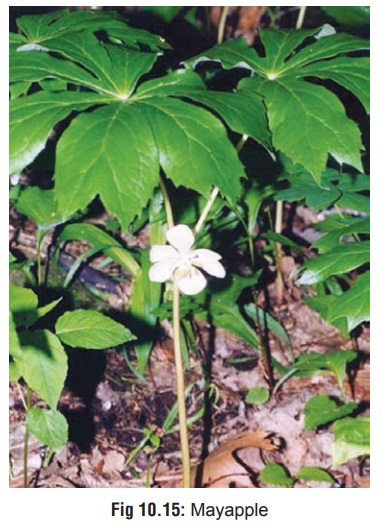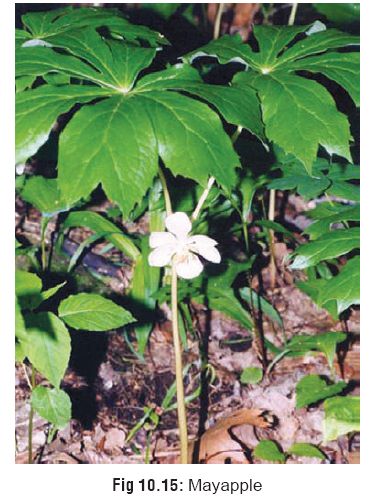Chapter: Modern Medical Toxicology: Organic Poisons (Toxins): Irritant Plants
Mayapple (May Apple) - Gastric Irritant Plants

Mayapple (May Apple)
Other Common Names
·
American Mandrake.
Botanical Name
·
Podophyllum
peltatum, Podophyllum hexandrum
Physical Appearance
·
This plant belonging to family
Podophylaceae grows well in the hilly regions of Sikkim, Uttar Pradesh, Punjab,
Himachal Pradesh, and Kashmir.
·
It is a flowering herb with a
creeping root stock with deeply lobed leaves having toothed margins (Fig 10.15).
·
Flowers are usually solitary,
cup-shaped, and white or pink in colour.
·
Fruits are generally ovoid and
bright scarlet.

Toxic Part
Leaves
and rhizomes.*
Toxic Principle
· Podophyllin (purified form: podophyllotoxin): Podophyllum is an amorphous caustic powder which is light brown to greenish-yellow or brownish-grey in colour having a characteristic odour, and is a mixture of at least 16 physiological compounds divided into two groups: lignans (wood extracts) and flavonols. It is present in the rhizomes and roots of the plant, and contains at least 50% podophyllotoxin. Commercial preparations usually contain 25% podophyllum resin in either tincture of benzoin, or 10% benzoin and 72% isopropanol. Both podophyllum and podophyllotoxin have a colchicine-like and vinblastine-like effect, resulting in the following chemical effects:
o Antimitosis:
arrest of mitosis in metaphase.N
o egative
effect on axoplasmic transport.
o Inhibition
of protein, RNA and DNA synthesis.
o Blocking
of oxidation enzymes in tricarboxylic acid cycle.
Uses
1.
Podophyllum and its resin are used
as keratolytic agents whose caustic action is thought to be caused by the
arrest of mitosis in metaphase.
2. Topical treatment of condyloma
acuminata (venereal warts).
3.
Podophyllum is also used in
Homoeopathy.
Clinical Features
Ingestion or dermal application could both result in
toxicity. The toxicity associated with podophyllum is colchicine-like,
arresting cellular mitosis in metaphase. Symptoms generally begin 30 minutes to
several hours following ingestion, and 12 to 24 hours after dermal absorption.
·
Exposure of eyes to podophyllum
powder causes intense irritation with conjunctivitis, keratitis, corneal
ulceration, and iritis.
·
Ingestion results in nausea,
abdominal pain, vomiting, and diarrhoea, followed by fever, tachypnoea,
peripheral neuropathy, tachycardia, hypotension, ataxia, dizziness, lethargy,
confusion, and altered sensorium. Seizures may occur. Polyneuropathy generally
appears in about a week, and progresses for 2 to 3 months.
·
After a few days, pancytopenia and
hepatic dysfunction may occur, which generally resolves in 2 to 3 weeks.
·
Cardiotoxicity, ileus, coma, and
hallucinations may also occur.
·
Autonomic dysfunction, including
sinus tachycardia, urinary retention, paralytic ileus, and orthostatic
hypoten-sion may persist for several months.
·
Oliguria, anuria, and renal failure
are rare complications.
·
Consumption of Chinese herbal
products containing extracts of podophyllum have caused neuropathies and
encephalopathy.
· It has been suggested that
podophyllum should not be used during pregnancy for the treatment of genital
warts due to the potential for severe myelotoxicity and neurotoxicity in the
mother. Also, there are indications that podophyllum may be teratogenic and
carcinogenic. Squamous cell carcinoma-like changes have been reported following
the dermal use of podophyllum in humans.
Treatment
Obtain baseline CBC, haemoglobin, electrolytes, calcium, and
renal and liver function tests.
·
Gastric decontamination: Emesis is
not indicated. Activated charcoal can help.
·
Symptomatic and supportive measures.
·
For hypotension: Infuse 10 to 20
ml/kg of isotonic fluid and place in Trendelenburg position. If hypotension
persists, administer dopamine or noradrenaline.
· Monitor electromyography and nerve
conduction velocity in all patients with symptoms of peripheral neuropathy.
· Patients generally recover from
thrombocytopenia and leukopenia within 1 month. Granulocyte colony-stimulating
factor (G-CSF), or filgrastim may be effective in acceler-ating recovery from
neutropenia following podophyllum poisoning.
· Due to the large molecular weight of
the compound it is unlikely that haemodialysis would be effective for removal
of podophyllum. Early charcoal or resin haemoperfusion has been suggested by
some investigators to be useful in facilitating neurological recovery in some
patients. But there is no conclusive evidence regarding its usefulness.
Autopsy Features
In
one reported case, postmortem examination revealed partial maturation arrest of
granulocytopoesis and a severe decrease in megakaryocytes. There were multiple
petechiae on the pleura, the peritoneal surfaces of many organs, and the
gastric mucosa. Severe pulmonary congestion was present, as well as marked
vascular congestion of the liver and kidneys. There was a small area of focal
acute necrotising bronchial pneumonia, and the brain was oedematous.
Related Topics